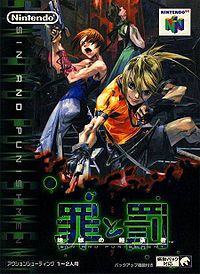From NintendoWiki, your source on Nintendo information. By fans, for fans.
| Sin and Punishment
|
| 罪と罰~地球の継承者
|

Cover artwork of Sin and Punishment
|
|
|
|
| N. America:
|
October 1, 2007 (Virtual Console)
|
| Japan:
|
November 21, 2000 (Nintendo 64)
September 20, 2007 (Virtual Console)
|
| Europe:
|
September 28, 2007 (Virtual Console)
|
|
|
|
Sin and Punishment, (罪と罰~地球の継承者 literally Sin and Punishment: Successor to the Earth) originally titled, Glass Soldier, is an on-rail shooter game for the Nintendo 64 developed by Treasure and Published by Nintendo. The game was first released in 2000 as a Japan exclusive, despite it originally having a release date outside Japan. (Probably due to the fact 2000 was towards the end of the Nintendo 64 lifespan). Sin and Punishment featured a combination of Japanese text and English Voice Acting during in-game, making it a more notable title on the platform. Because of high fan requests, along with the appearance of Saki Amamiya in Super Smash Bros. Brawl, Sin and Punishment was released in North America via the Nintendo Wii's Virtual Console function in September 2007, worth 1200 Wii Points, making it the highest priced Virtual Console title.
Story
In the year 2007, in present day Japan, a vast population growth had led to an unfortunate amount of food shortages. In an effort to solve the problem, scientists develop artificial life that can be eaten by humans. A large group of these organisms are left somewhere in Hokkaido Japan. However, over time, the organisms have adapted to attack humans, and since then, these violent creatures were referred to as "Ruffians". An international peace keeping organization from America named, the Armed Volunteers, were sent to destroy the Ruffians, but also have a dislike for the Japanese. Another force, the Relief Group, or Savior Group; lead by a woman named Achi (13 years old), supported by two other members, Airan Jo (15 years old), and Saki Amamiya (14 years old); set out to defeat the Ruffians and the Armed Volunteers.
Gameplay

|
This article is a stub. You can help NintendoWiki by expanding it.
|
